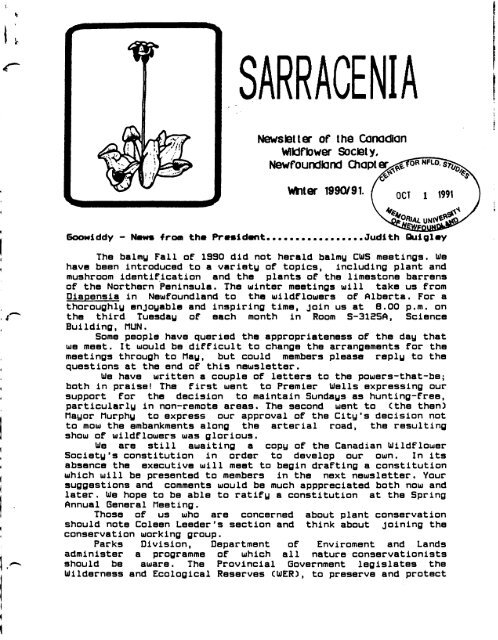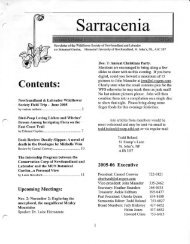sarracenia - The Wildflower Society of Newfoundland and Labrador
sarracenia - The Wildflower Society of Newfoundland and Labrador
sarracenia - The Wildflower Society of Newfoundland and Labrador
You also want an ePaper? Increase the reach of your titles
YUMPU automatically turns print PDFs into web optimized ePapers that Google loves.
1<br />
I<br />
.--- Winter- 1990/91 Page 5<br />
leaf scar-s:<br />
- shape <strong>of</strong> leaf scar-s Cnar-r-cwly U-shaped or- shield<br />
shaped),<br />
- number- <strong>and</strong> ar-r-angement <strong>of</strong> bundle tr-aces,<br />
- pr-esence or- absence <strong>of</strong> stipule scar-s,<br />
- shape <strong>of</strong> stipule scar-s.<br />
pith:<br />
- shape <strong>of</strong> pith in cr-ess-section Cr-cunded ver-sus star-shaped),<br />
- condition <strong>of</strong> pith in longitudinal section (continuous<br />
ver-sus chamber-ed or- spongy),<br />
- colour- <strong>of</strong> pith.<br />
GLOSSARY<br />
alter-nate- with one leaf, leaf scar- or- bud at each node.<br />
axil - the angle above a leaf; the point above a leaf scar-.<br />
axillar-y - positioned in the axil.<br />
bud - the over-winter-ing gr-owing tip <strong>of</strong> a br-anch. Usually,<br />
the bud occur-s at each leaf axil.<br />
bud scales - modified leaves or- stipules pr-otecting the<br />
inner- par-ts <strong>of</strong> the bud. Bud scales ar-e usually small <strong>and</strong><br />
har-d.<br />
bundle tr-aces or- scar-s - the points Cdots) on a leaf scarwher-e<br />
the vascular- tr-aces passed fr-om the stem into the<br />
leaf. <strong>The</strong> number- <strong>and</strong> relative position <strong>of</strong> bundle scar-s<br />
Cor- bundle tr-aces) is constant fer- a given species.<br />
chamber-ed pith - pith with cavities separ-ated by thin layer-s<br />
<strong>of</strong> tissue.<br />
continuous pith - pith unbroken by spaces; solid.<br />
imbr-icate scales - bud scales over-lapping like shingles.<br />
inter-node - the par-t <strong>of</strong> a stem between two nodes.<br />
later-al bud - the side buds, located along the twig.<br />
leaf scar- - scar-s located en the twig wher-e leaves wer-e<br />
attached. <strong>The</strong> size, shape <strong>and</strong> ar-r-angement <strong>of</strong> leaf scar-s<br />
are among the most impor-tant winter- char-acter-istics to<br />
obser-ve.<br />
lenticels - war-t-like dots or- shor-t lines br-eaking thr-ough<br />
the bar-k <strong>of</strong> most young twigs.<br />
naked bud - a bud without scales. <strong>The</strong> gr-owing tip <strong>of</strong> the bud<br />
is sur-r-ounded by the thickened fir-st pair- <strong>of</strong> leaves.<br />
node - the point <strong>of</strong> leaf attachment on stem or- twig.<br />
opposite - with two leaves, leaf scar-s or- buds at each node.<br />
pith - the centr-al, s<strong>of</strong>t par-t <strong>of</strong> a woody stem.<br />
scabr-ous - r-ough to the touch.<br />
sessile buds - net stalked, buds situated adjacent to leaf<br />
scar-s.<br />
spongy pith - por-ous, like a sponge.<br />
stipule scar-s - scar-s en the twig wher-e stipules have<br />
fallen. <strong>The</strong>se pair-ed scar-s, located one en each side <strong>of</strong> a<br />
leaf scar-, ar-e usually small. However- they may be <strong>of</strong><br />
unequal size, or- in some species, for-m a continuous r-ing<br />
I tf
Winter 1990/91 Page 9<br />
occurs as the leaves turn colour. As autumn approaches, the<br />
starch (storage material - ie. the plant's fat), chlorophyll, <strong>and</strong><br />
other important substances are transported to the young parts <strong>of</strong><br />
the plant - the new branches. <strong>The</strong> brilliant fall leaf colours are<br />
partly due to the unmasking <strong>of</strong> the yellow <strong>and</strong> orange pigments as<br />
the chlorophyll is lost. <strong>The</strong> bright red colours are due to an<br />
accumulation <strong>of</strong> red pigments which is favoured by bright, clear<br />
days <strong>and</strong> lower temperatures. Short days <strong>and</strong>/or lower temperature<br />
bring on the end <strong>of</strong> the leaves en trees.<br />
In the winter, twigs can be used for identification. You<br />
can use the Peterson Field Guide to Trees <strong>and</strong> Shrubs by Petrides.<br />
<strong>The</strong> important characteristics to notice are the arrangement <strong>of</strong><br />
the buds Care they in pairs opposite each ether or scattered in a<br />
loose spiral along the stem?), the shape <strong>of</strong> the buds, the number<br />
<strong>of</strong> bud scales Cwillows have just one bud scale), the colour <strong>of</strong><br />
the twig, <strong>and</strong> ether features mentioned in the field guide.<br />
Another interesting thing about twigs is their lenticels. <strong>The</strong>se<br />
are the 'specks' on the bark which are, in fact, spongy corks<br />
which plug holes in the bark so that air can get into the cells<br />
that are alive in the stem.<br />
In addition to enjoying our wild flowers we must also think<br />
this winter about how we can best preserve them. <strong>The</strong> countryside<br />
is being churned by all-terrain vehicles <strong>of</strong> all descriptions.<br />
Special places are being harmed. we have a responsibility to<br />
future generations.<br />
Report from the Botanical Garden •••••••••••••••• Anne Maria Madden<br />
At Memorial University Botanical Garden, hardly a day gees<br />
by without a request from one <strong>of</strong> cur visitors fer some kind <strong>of</strong><br />
gardening or nature information. <strong>The</strong> range <strong>of</strong> inquiries are<br />
diverse <strong>and</strong> sometimes daunting, as is the case when we are<br />
presented with a mysterious slip, section or sample <strong>of</strong> botanical<br />
origin <strong>and</strong> called upon to deliver a speedy <strong>and</strong> accurate<br />
identification. Often, we are limited to a mere verbal<br />
description, which in some cases, does net prove to be extremely<br />
helpful Ci.e. "What's that plant that you see EVERYWHERE, you<br />
know, it's green, <strong>and</strong> has lets <strong>of</strong> leaves, <strong>and</strong> the flower is<br />
really pretty?")<br />
But regardless <strong>of</strong> what we have to work en, there are a<br />
number <strong>of</strong> books, which we have grown to depend on as excellent<br />
sources <strong>of</strong> reference. Of course we have such volumes as Taxonomy<br />
<strong>of</strong> Vascular Plants by George H. M. Lawrence <strong>and</strong> Gray's Manual <strong>of</strong><br />
Botany. However many people, especially these just learning<br />
about wildflowers, find these volumes somewhat intimidating, <strong>and</strong><br />
are much mere at ease browsing through the familiar field guides.<br />
Any wildflower field guide pertinent to cur area can be<br />
used. Most bookstores <strong>of</strong>fer a limited variety <strong>of</strong> them, as do<br />
many bookclubs. At the Botanical Garden, A Field Guide to<br />
<strong>Wildflower</strong>s <strong>of</strong> Northeastern <strong>and</strong> Northcentral North America by<br />
Reger Tory Peterson <strong>and</strong> Margaret McKenny is a popular book. Here




